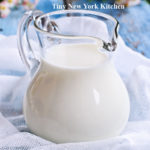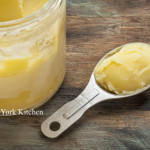Buttermilk is a fermented dairy drink that was traditionally the liquid left behind after churning butter out of cultured cream. Today, most modern buttermilk is cultured. Cultured buttermilk was first commercially introduced in the US in the 1920s. Commercially produced buttermilk is milk that has been pasteurized, homogenized, and then inoculated with a culture of Lactococcus lactis to simulate the naturally occurring bacteria in the old-fashioned buttermilk. The tartness of cultured buttermilk is primarily due to lactic acid produced by lactic acid bacteria while fermenting lactose, the primary sugar in milk.
Condensed buttermilk and dried buttermilk are very important in the food industry. Liquid buttermilk is used primarily in the commercial preparation of baked goods and cheese. Buttermilk solids are used in ice cream manufacturing as well as being added to pancake mixes to make buttermilk pancakes.
Buttermilk reacts with the baking soda and powder to give quick breads their rise and tender crumb. The reaction is best at the beginning, you’ll want to get the loaf in the oven right after mixing the wet and dry ingredients. Buttermilk can also be used in marinating meats, especially chicken and pork, because the lactic acid helps to tenderize, retain moisture, and allows added flavors to permeate the meats.
©Tiny New York Kitchen © 2021 All Rights Reserved
Shop the peripheries of the supermarket and stay out of the middle. Most supermarkets are laid out the same way. Processed food products dominate the center aisles of the store, while the cases of mostly fresh food (produce, meat, fish, dairy) line the walls, Keep to the edges of the store and you’ll be much more likely to wind up with real food in your shopping cart. This strategy is not foolproof, however, since things like high-fructose corn syrup have crept into the dairy case under the cover of flavored yogurts and the like.
If you want to lower your risk of heart disease and lose weight, without feeling deprived, the Mediterranean diet just might be the plan for you. The Mediterranean diet is known for being one of the healthiest eating patterns and one of the easiest plans to follow. In fact, research has shown that it can lower bad cholesterol, lower risk for certain types of cancer, and even improve brain health. The Mediterranean diet doesn’t call for eliminating entire food groups, but encourages smart choices from each.
GRAINS
Many of the grains you will find available in the Mediterranean diet, like barley and buckwheat, are whole grains, which have so many health benefits. Whole grains are not only packed with heart-healthy vitamins and antioxidants, they also contain fiber. Fiber is good for digestive health and heart health, as it can help lower LDL cholesterol (the type of cholesterol that causes heart disease). The Mediterranean diet also encourages enjoying whole-grain breads with olive oil instead of butter because of the heart-health benefits.
FRUITS & VEGETABLES
The diet places an emphasis on consuming plenty of fruits and vegetables. Cucumbers, tomatoes, kale, onions, bell peppers, broccoli, and spinach are all great examples. Combining vegetables with whole grains, in a pasta salad or couscous for example, is a great way to enjoy both. Fruits such as berries, apples, melons, and figs all make great snack or even dessert options. For breakfast you can easily combine fruits with whole grains for a breakfast muesli or try blueberry pancakes made with buckwheat.
PROTEIN
Protein from lean sources such as poultry and seafood are encouraged at least twice a week. However, red meat is supposed to be limited to only a few times per month. Seafood is encouraged because of the heart healthy fats, which are good for brain and heart health. Lean poultry is encouraged because it’s low in saturated fat, but high in protein, which is good for muscle building and satiety. Lemon chicken salad or Tuscan chicken stew would both be great dishes to include on the plan.
DAIRY
Dairy is allowed on the Mediterranean diet, but moderation is key. Instead of fat-free or sugar-free yogurt, switch to plain Greek yogurt, which is lower in sugar, but higher in protein. Low-fat milk and cheeses like feta and brie are also allowed, but moderation is encouraged because of their saturated fat and sodium content. For a simple and healthy weeknight dinner, try combining grilled chicken kabobs with a lemon-dill Greek yogurt dipping sauce.
NUTS & LEGUMES
Nuts, seeds, and legumes are encouraged because they contain heart-healthy fats and fiber. Almonds, walnuts, cashews, peanuts, and sesame seeds can be enjoyed as a snack or sprinkled on vegetables or hot cereals. Legumes, such as split peas and red lentils, are great in soups, stews or on top of salads. Try making hummus at home by using chickpeas, olive oil, and lemon juice, then enjoy it with grilled chicken, sliced bell peppers, and whole-wheat pita bread.
HEART-HEALTHY FATS
Saturated fats like butter are discouraged on the Mediterranean diet, which instead urges heart-healthy fats from olive oil, nuts, seeds, and avocados. Heart-healthy fats can actually help raise HDL cholesterol, which is the good cholesterol that our bodies make in order to fight heart disease. To incorporate them, opt for a baked potato with a drizzle of olive oil, or try adding diced avocado to green salads with grilled chicken. If creamy chicken salad is more your pace, serve it with chopped olives.
SEASONINGS
Instead of using salt to season your dishes, the use of herbs and spices is highly encouraged on the Mediterranean diet. Garlic, rosemary, thyme, sage, mint, and basil are all great flavors to add to simply grilled chicken or green salads. Citrus juice from lemons, limes, and oranges can also add flavor that’s perfect for salads and marinades. Try experimenting at home with different seasonings, and find what works for you.
VARIETY & BALANCE
The Mediterranean diet has a lot to offer in terms of variety and health benefits. In additions to focusing on making smart choices, the plan also encourages family meals and making time for physical activity. Lean protein, whole grains, fruits, vegetables, and low-fat dairy are all smart choices that can help you maintain a Mediterranean-style eating pattern. One you and your family can stick to.
“Work With What You Got!”
©Tiny New York Kitchen © 2019 All Rights Reserved
How To Clarify Butter
Some recipes call for clarified butter. To make it, just melt butter over a medium-low heat until the milk solids separate and rise to the top, 3 to 5 minutes. Let cool, then skim off the white foam and discard. Spoon remaining clarified (clear) butter into a bowl; discard the solids left at the bottom of the pan.
“Work With What You Got!”
© Victoria Hart Glavin Tiny New York Kitchen © 2016 All Rights Reserved
Paleo Diet
The Paleo Diet (short for Paleolithic) is fashioned around the eating habits and available foods of our hunter-gatherer ancestors. These ancestors had to nourish themselves with the meat, fish, fruits, vegetables, nuts, and fats available to them in nature. With the benefit of large supermarkets, it’s easy today to mimic these foods in wider variety. Specific recommendations for eating Paleo will vary; however, the main ideas are the same: Reduce the risk of debilitating diseases and optimize health by eating whole, fresh, unprocessed foods and avoid foods that were not available prior to the advent of modern agriculture.
Research studies looking at the Paleo Diet have noted that eating a Paleo Diet for a short term improved the glucose control and lipid profiles in people with type 2 diabetes, compared to eating a diet containing low-fat dairy, moderate salt intake, whole grains, and legumes. Additional research indicates similar results may be possible in people without type 2 diabetes as well. The Paleo diet may result in higher levels of satiety (fullness) throughout the day when compared with a low-fat, low-calorie diet.
Paleo Do’s
Eat plenty of non-starchy vegetables and fruits.
Make fresh meat, poultry, fish, and seafood your primary sources calories.
Avoid highly processed meats that contain preservatives, artificial flavors, and sugar, such as some sausages, bacon, deli meats, and smoked fish products.
Consume nuts and seeds.
Use coconut oil, grass-fed butter, olive oil, avocado oil, nut and seed oils, and animal fats, such as goose fat or duck fat, for cooking and eating.
Balance the intake of acid-producing foods (meats, fish, salt, and cheese) with base-producing foods (fruits and vegetables) for optimal health.
Use sea salt to season foods, but try to decrease sodium intake in general.
Paleo Don’ts
Consume highly processed packaged foods.
Get heavy handed with the salt shaker.
Eat grains of any kinds. Quinoa, bulgur, rice, wheat, bread, pasta, etc., are all out.
Consume sugar (including honey and maple syrup), sweets, candy, or desserts.
Use artificial sweeteners, such as monk fruit extract, stevia, NutraSweet or Equal (aspartame), Splenda (sucralose), or sugar alcohols, such as xylitol, sorbitol, or maltitol.
Eat legumes, beans, peas, lentils, or soy, or foods make from soybeans.
Use canola or soybean oils or consume hydrogenated oils (trans fats).
Consume dairy, with the exception of fermented dairy or raw milk cheese on occasion.
“Work With What You Got!”
© Victoria Hart Glavin Tiny New York Kitchen © 2016 All Rights Reserved















